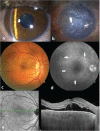Sympathetic Ophthalmia: Demographic Characteristics, Clinical Findings, and Treatment Results
- PMID: 36847630
- PMCID: PMC9973214
- DOI: 10.4274/tjo.galenos.2022.53383
Sympathetic Ophthalmia: Demographic Characteristics, Clinical Findings, and Treatment Results
Abstract
Objectives: To evaluate the demographic characteristics, clinical findings, and treatment approach of patients with sympathetic ophthalmia (SO).
Materials and methods: The records of 14 patients with SO between 2000 and 2020 were retrospectively reviewed. The patients' Snellen best corrected visual acuity (BCVA), detailed ophthalmological examination, optical coherence tomography (OCT), enhanced depth imaging-OCT (EDI-OCT), fundus fluorescein angiography findings, and treatment approaches were recorded.
Results: The study included the 14 sympathizing eyes of 14 patients with SO (7 female, 7 male). The mean age was 48.5±15.4 years (range: 28-75), and the mean follow-up duration was 55.1±48.7 months (range: 6-204). Ten patients (71%) had a history of ocular trauma and 4 (29%) had a history of ocular surgery. The time to symptom onset in the sympathizing eye after trauma or ocular surgery ranged from 15 days to 60 years. The most common posterior segment findings were optic disc edema (36%) and exudative retinal detachment (36%). In the acute period, the mean choroidal thickness value on EDI-OCT was 716.5±63.6 μm (range: 635-772) and decreased to 296±81.6 μm (range: 240-415) after treatment. Treatment with high-dose systemic corticosteroid was given to 8 patients (57%), azathioprine (AZA) to 7 (50%), AZA and cyclosporine-A combination to 7 (50%), and tumor necrosis factor-alpha inhibitors to 3 patients (21%). Recurrence was observed in 4 patients (29%) during follow-up. At last follow-up, BCVA values were better than 20/50 in 11 (79%) of the sympathizing eyes. Remission was achieved in 13 patients (93%), but 1 patient (7%) lost her vision due to acute retinal necrosis.
Conclusion: SO is a bilateral inflammatory disease that presents with granulomatous panuveitis after ocular trauma or surgery. Favorable functional and anatomical results can be obtained with early diagnosis and initiation of appropriate treatment.
Keywords: Imaging; Vogt-Koyanagi-Harada; optical coherence tomography; sympathetic ophthalmia; treatment.
©Copyright 2023 by Turkish Ophthalmological Association Turkish Journal of Ophthalmology, published by Galenos Publishing House.
Conflict of interest statement
Conflict of Interest: No conflict of interest was declared by the authors.
Figures



References
-
- Yang J, Li Y, Xie R, Li X, Zhang X. Sympathetic ophthalmia: Report of a case series and comprehensive review of the literature. Eur J Ophthalmol. 2021;31:3099–3109. - PubMed
-
- Zaharia MA, Lamarche J, Laurin M. Sympathetic uveitis 66 years after injury. Can J Ophthalmol. 1984;19:240–243. - PubMed
-
- Gasch AT, Foster CS, Grosskreutz CL, Pasquale LR. Postoperative sympathetic ophthalmia. Int Ophthalmol Clin. 2000;40:69–84. - PubMed
-
- Chang GC, Young LH. Sympathetic ophthalmia. Semin Ophthalmol. 2011;26:316–320. - PubMed
MeSH terms
Substances
LinkOut - more resources
Full Text Sources
Medical
